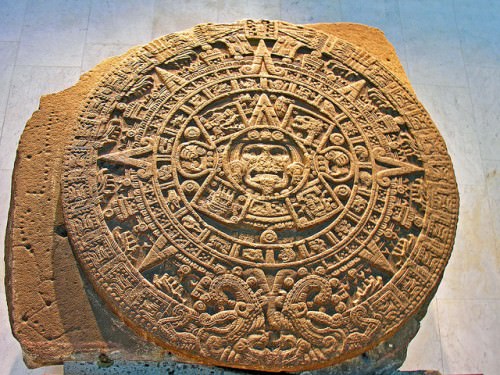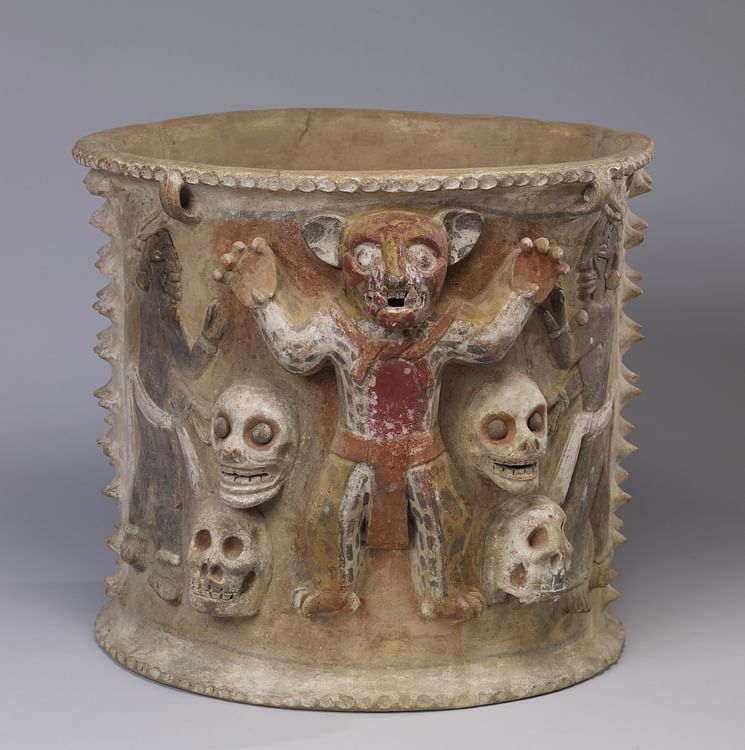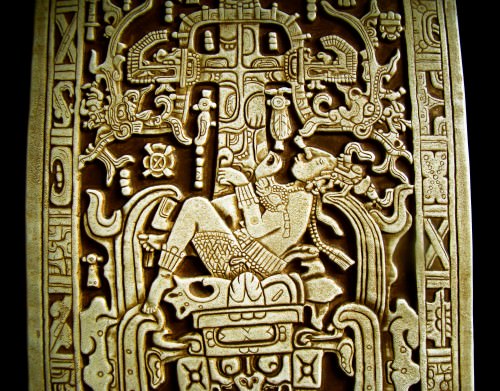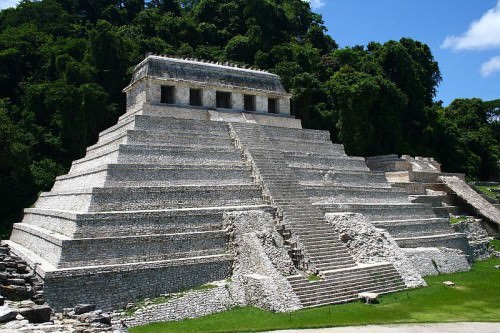Tezcatlipoca › Xibalba » Ancient origins
Articles and Definitions › Contents
- Tezcatlipoca › Who Was
- Xibalba › Who Was
Ancient civilizations › Historical and archaeological sites
Tezcatlipoca › Who Was
Definition and Origins

Tezcatlipoca ( pron. Tez-ca-tli-po-ca) or 'Smoking Mirror' in Nahuatl was one of the most important gods in Postclassical Mesoamerican culture and a particularly important deity for the Toltecs (from the 10th century CE) and later, for the Aztecs, most especially at Texcoco. Often considered as the supreme god he took on a bewildering array of names and manifestations depending on where and by whom he was worshipped. Invisible and omnipotent, he was known as a Creator god, the god of sustenance, a patron of warriors and as the bringer of both good and evil he was the very embodiment of change through conflict.
Tezcatlipoca was the 10th of the 13 Lords of the Day and associated with the horned owl in the Mesoamerican calendar whilst his nagual or animal spirit was the jaguar. For the Mexica he was associated with day 1: Death and the god was especially worshipped during Tóxcatl, the 6th month of the 18-month solar year with those who did revere the god carrying the epithet titlacauan, meaning 'we are his slaves', indicative perhaps that, for good or bad, there was no escaping the attentions and influence of Tezcatlipoca.
A CREATOR GOD
Tezcatlipoca was believed to be the son of the primordial androgynous god Ometeotl. In Aztec mythology he was the brother of Quetzalcoatl, Huizilopochtli and Xipe Totec. In the complex Mesoamerican creation myths Tezcatlipoca ruled the first world of the Sun but was then overthrown by Quetzalcóatl. The two later cooperated, however, to create the 5th Sun.Transformed into giant snakes, the two gods attacked and dismembered the female reptilian monster known as Tlaltcuhtli (or Cipactli), one part became the earth and the other the sky. Trees, plants and flowers sprang from the dead creature's hair and skin whilst springs and caves were made from her eyes and nose and the valleys and mountains came from her mouth.
THE GOD COULD INTERVENE DIRECTLY IN HUMAN AFFAIRS TO BRING BOTH HAPPINESS AND SORROW.
THE MANY FACES OF TEZCATLIPOCA
Sharing traits with the earlier God II of the Classic Maya, Tezcatlipoca was often regarded as the one supreme omnipotent god in various Mesoamerican cultures and all other gods could be considered as manifestations of this one great being. He was known as Black Tezcatlipoca or the 'Smoking Mirror', god of the day and of Texcoco. The mirror may signify that the god is all-seeing or that he rules over all of the earth, sometimes referred to as a smoking mirror. He is also known as Blue Tezcatlipoca, the 'Hummingbird Sorcerer', god of Tenochtitlán, where he was associated with the sun and the war god Huitzilopochtli. He could be known as Red Tezcatlipoca, the 'Flayed One' and associated with the gods Camaxtli and Xipe Totec (god of the Tlaxcaltecans) or as White Tezcatlipoca, the 'Plumed Serpent' or Quetzalcóatl, god of the Cholula. Yet another manifestation of the god was as Tepeyolohtli, the jaguar god that lived in the centre of the mountain of the earth.
Ever-present, the god could intervene directly in human affairs to bring both happiness and sorrow. Tezcatlipoca could take on more sinister connotations when he was known as lord of the shadows or night, a sorcerer of black magic and the bringer of evil, death and destruction as Chalchiuhtecólotl, 'Precious Owl' or Chalchiuhtotolin, 'Precious Turkey '. Also associated with conflict he was known as Yaotl or 'Enemy' and was patron of warriors and their training camps ( telpochcalli ). He was not always protective to soldiers, though, for sometimes he could be found at crossroads at the dead of night, ready to challenge any unsuspecting warriors.
In a similar vein, Tezcatlipoca could represent those other disagreeable elements of the human condition: intense cold, sin and misery when he took on the guise of Itztlacoliuhqui. Finally, in a more positive role, when he was Omácatl, he was seen as the patron of the aristocracy and feasts. In keeping with the god's complex character of conflicting opposites, though, in this role he could at the same time represent thieves and evil sorcerers.

Aztec Sun Stone
TÓXCATL CEREMONIES
In the month of Tóxcatl, the sixth month (or 5th) of the Aztec solar year, Tezcatlipoca was worshipped in special ceremonies.As with other Aztec religious rites an important part of the ceremony was the impersonation of the god, most often by a prisoner of war, typically the best looking and most courageous one. For one year before, in fact, the captive was tutored by priests, treated as a noble and even given four women to look after him. These women themselves impersonated four goddesses - Atlatonan, Huixtocihuatl, Xilonen and Xochiquetzal. When the special month finally came around the impersonator was handsomely dressed in a warrior costume and in a symbolic wedding festival he married his four goddesses. Honoured with flowers and dances the man-god was then ferried to a dedicated temple where he was promptly sacrificed and his heart removed to honour the real Tezcatlipoca.
MYTHICAL ADVENTURES
Besides the Creation, Tezcatlipoca is involved in many mythical tales and one of the more curious is the arrival of the first dogs. The trouble began with the old couple Tata and Nene, survivors from the flood which had previously destroyed the 4th world. Finally making land they beached their cypress log boat and proceeded to make a fire by rubbing sticks together. Then they decided to cook a fish but the smoke from their fire disturbed the stars, especially Citlallatonac and Citlalicue. These gods complained vociferously to Tezcatlipoca who, perhaps a little harshly, lopped off the heads of the couple and reattached them to their backsides, thus, the very first dogs were created.

Tezcatlipoca
Another story explains Tezcatlipoca's association with music. One day the god instructed a black wind god to go to the sun and fetch some music. The wind god needed help for such a dangerous mission and so he enrolled Tezcatlipoca's assistants - a turtle, mermaid and a whale - these he put together to make a bridge so that he might cross the ocean. The sun saw the wind god arriving and warned his entourage of musicians not to answer any demands the wind might make, otherwise, they would be sent back to earth with the wind. However, the wind god started singing in such an irresistible manner that one of the musicians felt compelled to answer and so he was punished by the sun and made to return to earth, bringing with him the gift of music. The god's love of music was also displayed during the ceremony in Tóxcatl where the Tezcatlipoca impersonator broke a flute every step of the pyramid he climbed on his way to being sacrificed.
REPRESENTATIONS IN ART
The earliest certain representations of the god in art appear in the stone sculpture of the Chichen Itzá in the Early Postclassical period (900-1200 CE). Here he may have a smoking mirror on his head and a serpent in place of a foot, whilst in later depictions of the god he has a polished black obsidian mirror instead of a left foot. This replacement of the foot is a reference to a wound he received in his famous battle with Tlaltecuhtli during the Creation. He is often in the company of a turquoise snake, may have stripes painted on his face in yellow and black and wear a costume with corn designs (in reference to his role as god of the dry season and war) and skulls and bones (as he is an underworld god). Sometimes he carries four arrows in his right hand, weapons he uses to punish wrongdoers. The god could be depicted in different colours depending on which cardinal point he was representing - black for north, blue for south, red for east and white for west.
Tezcatlipoca is often represented wearing a turquoise mask with a black eye band. Indeed, one of the most famous art objects of the god is the decorated skull now in the British Museum in London. The skull is covered in turquoise and black lignite mosaic with red thorny oyster shell in the nasal cavity. Polished pyrite surrounded by white conch shell provide the eyes. The mask interior is lined with deerskin and the same material is used for the two straps attached to the skull. This striking object may well be one of the gifts that the Aztec king Montezuma II gave to Hernando Cortés in 1519 CE.
Xibalba › Who Was
Definition and Origins

Xibalba (Shee-bal-ba) was the name the K'iche Maya gave to the underworld. For the Yucatec Maya the underworld was known as Metnal. The name Xibalba translates as 'Place of Fright', which indicates the terror the place had in the Maya imagination. There was, unfortunately, not much chance of escaping the place, either. Ideas such as leading a good life and avoiding eternal torment by not doing bad things were not part of the Maya belief system, as only those who died a violent death avoided Xibalba. The underworld was a truly fearsome place, strongly associated with water; it had its own landscape, gods, and blood-thirsty predators. Xibalba was also the scene of many adventures by the heroes of Maya mythology, especially the Hero Twins.
THE GEOGRAPHY OF XIBALBA
For the Maya Xibalba lay to the far west, hence the great number of burials made on the islands of Campeche, located off the west coast of the Yucatan peninsula, making it the most western Maya territory. Xibalba was entered through a cave or area of still water in Tlalticpac, which was the surface of the earth and the first of the nine underworld levels. The Milky Way was also considered an entrance to Xibalba and the road along which souls walked to meet their fate. The Maya, believing the underworld had nine different levels, represented this idea in the gigantic stone pyramids they built as tombs for their kings which often have nine tiers. See, for example, the Temple of the Inscriptions at Palenque, Temple I at Tikal, or the Pyramidof Kukulcan at Chichen Itza.
IN XIBALBA FLESH FALLS FROM THE BODY, EYES HANG FROM THEIR SOCKETS, AND BODILY FUNCTIONS ARE NO LONGER CONTROLLED.
The Maya believed that the underworld was ruled by a group of gods (possibly 9 or 14), known collectively as the lords of the underworld. These have fearsome names and include 1 Death and 7 Death (the two most important), Pus Master, Bone Sceptre, Skull Sceptre, Jaundice Master, Blood Gatherer, and Bloody Claws. Many of these lords could occasionally come up to the world of the living where they would spread misery and disease. The Maya also believed that each astronomical god had its own manifestation in the underworld. For example, the Sun God K'inich Ajaw, when he was travelling through the underworld at night, became the Jaguar God of the Underworld.The most important Maya religious book, the Popol Vuh ,describes some details of the geography within Xibalba. The underworld is vast with as much variety in landscape as the outside world of the living. Further, there are two great rivers, perhaps more, which run through it. To reach the ninth level of Xibalba, many trials and dangers had to be faced by the dead. These included the crossing of dangerous waters and high mountains, rivers of blood, attack by spinning obsidian knives and arrows, and even the sacrifice of one's heart. To help the soul survive such an ordeal, the dead were buried or cremated with useful pieces of equipment such as weapons, tools, weaving kits, precious goods like jade, sustaining food such as hot chocolate, and even dogs (real or pottery effigies) to act as companions and guides.

Pakal the Great & Xibalba
XIBALBA IN THE POPOL VUH
As we have seen, the Maya expected to undergo trials in Xibalba, and if they could use their skills and intelligence, then they had a chance to outwit the terrible demons and trials awaiting them there. One of the most celebrated stories involves the Maize God (Hun Hunahpu or 1 Ajaw) and his brother 7 Hunahpu. Playing a noisy game of ball one day, the pair angered the lords of the underworld who summoned them to descend into Xibalba. After suffering many trials and horrors, the siblings played another game of ball. This time, on losing the game, they were sacrificed and buried under the ballcourt, whilst the Maize God's head was placed in a calabash or cacao tree. Later, a daughter of one of the lords of the underworld, Blood Maiden, saw the head and after a little conversation and with the head spitting in her hand, she miraculously became pregnant with twins. These siblings were Hunahpu (or Hun Ajaw) and Xbalanque (or Yax Bahlam), the famous Hero Twins of Maya mythology, who would gain fame as great hunters, practical jokers and superb ball players.
History repeated itself and the Hero Twins, like their father and uncle, were also summoned into Xibalba and, after being held captive in terrible chambers with Death Bats, jaguars, terrible cold, and fires, were also made to play a game of ball. This they won, but it did them no good as they were executed anyway, or rather, the lords of the underworld hoped to kill them, but the twins acted first and leapt into a tremendous fire. However, the gods of the outer world were not best pleased at this result, and so they brought the twins back to life. Now disguised as dancers, the pair wreaked havoc in Xibalba, slew the lords of the underworld, and even managed to resurrect their father the Maize God. The three, along with a bevy of naked maidens and now laden with treasure, then used a canoe to finally escape from Xibalba and return to the land of the living. The whole myth is most probably a colourful metaphor for the planting of maize seeds into the earth and their subsequent growth back above the earth's surface.

Temple of the Inscriptions, Palenque
XIBALBA IN ART & ARCHITECTURE
The various gods and characters involved in the myths concerning Xibalba are frequently seen in Maya art, such as pottery decoration, stone reliefs, incised bones, and cave paintings - especially at Naj Tunich. The imagery of souls in the underworld is often horrific. Flesh falls from the body, eyes hang from their sockets, and bodily functions are no longer controlled. One of the most striking representations of Xibalba is on the c. 683 CE sarcophagus of the king of Palenque, Pakal the Great, found deep within the Temple of Inscriptions at Palenque. Here the dead ruler is depicted falling backwards into the huge, gaping centipede jaws of the underworld. The underworld was also represented in Maya architecture. Pyramids which were intended as tombs, as noted above, had nine platforms to represent the nine levels of the underworld. In addition, at Utatlan the ballcourt is thought to represent Xibalba, and the South Building of the Nunnery complex at Uxmal is also, with its lower level and nine doorways, thought to visually represent Xibalba.

The Lost Gods: The Maya (Planet Knowledge)
LICENSE:
Article based on information obtained from these sources:with permission from the Website Ancient History Encyclopedia
Content is available under License Creative Commons: Attribution-NonCommercial-ShareAlike 3.0 Unported. CC-BY-NC-SA License